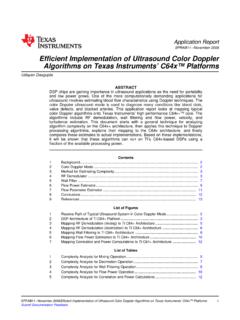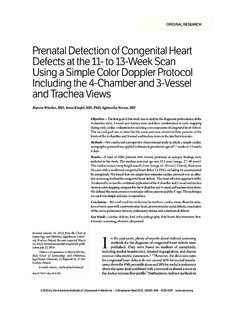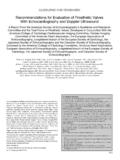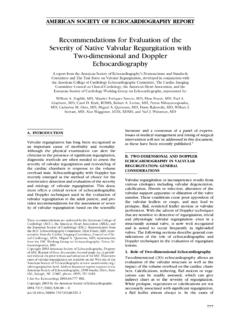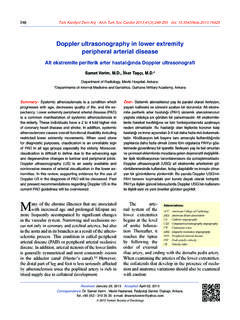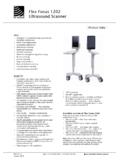Transcription of Doppler Color Flow Imaging #4 - Cardioland
1 Doppler Color Flow Imaging #4 Joseph A. Kisslo, MD David B. Adams, RDCS INTRODUCTION Doppler Color flow Imaging is a method for noninvasively Imaging blood flow through the heart by displaying flow data on the two-dimensional echocardiographic image. This capability has generated great excitement about the use of the technique for identifying valvular, congenital, and other forms of heart disease, as the Color flow image imparts spatial information to the Doppler data. To inexperienced Doppler users, the Color flow display makes the Doppler data more readily understandable because of the avoidance of complex spectral velocity displays.
2 Color FLOW Imaging IN CLINICAL PRACTICE Doppler Color Flow Imaging In Figure there is a mitral regurgitant jet into the left atrium in systole and the regurgitant blood flow is displayed on the two-dimensional echocardiographic image. In Color flow Imaging , the colors red and blue represent direction of a given jet; the various hues from dull to bright represent the differing velocities. When turbulence is present, a mosaic of many colors results. A two-dimensional display of flow is, therefore, produced with ready identification of size, direction, and velocity.
3 The Meaning of Color The colors displayed on the flow map image contain useful information. By convention, Doppler Color flow systems assign a given Color to the direction of flow; red is flow toward, and blue is flow away from the transducer. Three typical Color bars from a Color flow Imaging device are shown in Figure and give an initial frame of Figure 4. 1 Systolic parasternal long-axis Color flow image of mitral regurgitation. The mitral regurgitation jet comprises a mosaic of varying colors. A variance map is used. Note the direction of flow indicated by the Color bar on the right (Abbreviations, page 39).
4 Figure 4. 2 Three Color bars from a Color flow system. When there is no flow, black is displayed (center) in the standard bar (left), flow toward the transducer at the top is in red, flow away in blue. Progressively faster velocities are displayed in brighter shades of red or blue. The center bar is in an enhanced map, and the right bar in a variance map (explained later in the text). reference to the meaning of colors. Such Color reference bars always appear on the screen of Doppler flow Imaging devices. The center of the standard Color bar on the left is black (white center reference mark) and represents zero flow.
5 In addition to simple direction, velocity information is also displayed. Progressively increasing velocities are encoded in varying hues of either red or blue. The more dull the hue, the slower the velocity. The brighter the hue, the faster the relative velocity. In the Color bar shown in the center of Figure , the colors have been enhanced so that the hues of red are increased from very dull red to bright yellow and the hues of blue are increased from very dull blue to a bright pale blue. The enhanced map helps a beginner to understand the relationship between velocity and Color .
6 The bar at the right demonstrates variance. As will be seen later, Color is also used to display turbulent flow and allows an operator to discriminate between normal and abnormal flow states. The Angiographic Concept One way of conceptualizing Doppler Color flow methods is to recognize its similarity to angiography. It provides a noninvasive angiogram of blood flow, where the contrast medium is the moving red blood cells and the detector of this contrast is ultrasound. The complex Doppler ultrasound processing circuitry allows for the detection of movement of these red cells in various directions forward and backward through the heart.
7 Doppler Color flow information, however, is obtained and displayed in a cross-sectional image, making the spatial details of flow and anatomy readily recognizable. In effect, Doppler Color flow looks inside the cineangiographic silhouette. Unlike angiography, Doppler Color flow does not depend on dye dilution accumulated over several heartbeats. Rather it displays an abnormal flow jet for each cardiac cycle. This results in the ability to display the differing sizes of regurgitant jets depending on severity. The larger the volume of the regurgitant jet, the larger the size represented on the display.
8 CREATION OF THE Color IMAGE The Importance of Time Time is the key factor to keep in mind. A conventional two-dimensional ultrasound Imaging system is already working as hard as it can. Pulses must be transmitted along a given line, reflected from the heart valves and walls, then received. The process is repeated, line by line, through the entire sector arc that comprises several hundred lines. This completes one frame of information, usually in one-thirtieth of a second. In order to have the image appear as though it is continuously moving, the entire image must be updated 30 times in a second (30 frames/second).
9 This results in relatively long waiting periods for the transmit-receive sequence to be completed. It also means that considerable amounts of information need to be quickly processed and presented in the image. A problem, therefore, results. If all this time is taken to simply create the image, where is there time to sample rapidly with the Doppler , left and right, in all portions of the image field? From earlier units in this series, we have already learned that high quality Imaging and high quality pulsed Doppler cannot really be conducted simultaneously.
10 Anatomic and Flow Information Together Expressed in its most simplistic terms, Color flow systems add a separate processor that creates the Color flow image based on the returning data and then integrates it with the two-dimensional anatomic image (Fig. ). Both the anatomic and the Color flow data are then displayed in the final image. The returning ultrasound data from any conventional scanner also contains frequency shift information that results from the encounter of the transmitted pulse with moving structures and blood. Until the advent of Color flow Imaging , this frequency shift data was simply ignored.




